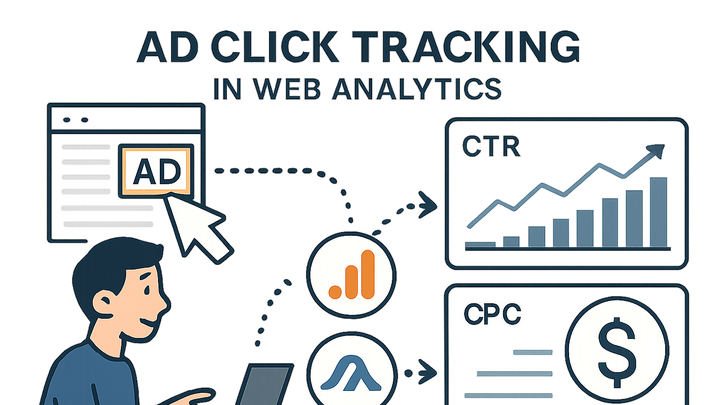Published on 2025-06-22T01:42:15Z
What are Ad Clicks? Definition and Examples
Ad clicks refer to the number of times users interact with online advertisements by clicking on them. This fundamental metric is used in web analytics to gauge ad engagement, measure marketing performance, and optimize advertising campaigns. Tools like Google Analytics 4 (GA4) and PlainSignal (a cookie-free simple analytics solution) provide mechanisms to capture and report ad click events. By tracking ad clicks, marketers can understand which ads resonate with audiences, calculate key metrics such as click-through rate (CTR) and cost per click (CPC), and inform budget allocation decisions. While GA4 allows event-based tracking through gtag or Google Tag Manager, PlainSignal offers a lightweight, privacy-friendly script that automatically logs click interactions. Accurate ad click tracking is crucial for attribution, ROI calculation, and refining ad creatives and targeting strategies. However, care must be taken to avoid duplicate events, ensure proper naming conventions, and comply with privacy regulations.
Ad clicks
Counts of user clicks on online ads used to measure engagement and calculate metrics like CTR and CPC.
Why Ad Clicks Matter
Ad clicks are a primary indicator of user engagement with your advertising campaigns. They reveal which creatives, messages, and channels resonate best with your audience. Tracking ad clicks helps marketers evaluate campaign effectiveness, optimize ad spend, and improve targeting strategies. Additionally, ad click data feeds into attribution models, informing how credit for conversions is allocated across touchpoints. By analyzing click patterns, businesses can refine ad design and placement for higher ROI.
-
Engagement indicator
Measures how compelling an ad is by showing how many users interact with it.
-
Attribution foundation
Serves as a key data point in attribution models to understand the customer journey.
-
Budget optimization
Helps allocate marketing spend to ads and channels that drive the most clicks.
How to Track Ad Clicks
Ad click tracking can be implemented via analytics platforms or custom scripts. Below are methods for two popular tools.
-
Google analytics 4 (GA4)
In GA4, clicks can be tracked as custom events. You can configure click event tracking using the gtag.js snippet or deploy tags via Google Tag Manager. For example, to record an ad click with gtag you might use:
gtag('event', 'ad_click', { 'event_category': 'Ads', 'event_label': 'Spring_Sale_Banner' }); -
PlainSignal (cookie-free analytics)
PlainSignal automatically captures click interactions through its lightweight script without relying on cookies. Simply include the tracking snippet on your site and ad click events are logged out of the box. Example code:
<link rel="preconnect" href="//eu.plainsignal.com/" crossorigin /> <script defer data-do="yourwebsitedomain.com" data-id="0GQV1xmtzQQ" data-api="//eu.plainsignal.com" src="//cdn.plainsignal.com/plainsignal-min.js"></script>
Related Metrics
Ad clicks form the basis for calculating several key performance indicators (KPIs) that help evaluate advertising success.
-
Click-through rate (ctr)
Percentage of ad impressions that result in clicks. Formula: CTR = (Ad Clicks / Impressions) × 100%.
-
Cost per click (cpc)
Average cost paid for each ad click. Calculated as total ad spend divided by number of clicks.
-
Conversion rate
Percentage of clicks that lead to a desired action (e.g., purchase, signup).
Best Practices and Common Pitfalls
Implementing ad click tracking effectively requires careful planning and ongoing monitoring.
-
Avoid duplicate events
Ensure each click event fires only once per interaction to prevent inflated metrics.
-
Consistent naming conventions
Use a standardized event naming scheme to make reporting and analysis easier.
-
Privacy compliance
Adhere to regulations such as GDPR and CCPA. Consider using cookie-free solutions like PlainSignal.
